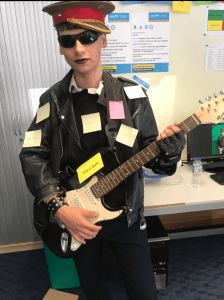My image that uses mise-en-scene to communicate meaning.
Moodboard
We were given the genre of Punk and in our moodboard we included pictures of artists, styles and mise-en-scene that are associated with the punk rock genre. We found that the conventions of punk are:
- Leather jackets
- Extreme make-up in bright colours or black
- Fingerless gloves, chains and studded jewelry
- Vibrant and rebellious hair styles
- Agressive facial expressions
We decided that some of the most important and prominant aspects of punk was the leather clothing, extreme and individual hair and make-up styles, and the defiant facial expressions. We found that the punk style gave off a very rebellious, defiant and anarchic vibe which we tried our best to interpret when creating our star image.
People were asked to stick a post-it note onto our model with an adjective to describe the mise-en-scene in relation to the music genre. Some examples are:
- Rebellious
- Angry
- Intimidating
- Dangerous
- Edgy
- Individual
This was useful for us because it confirmed that we had created the correct atmosphere with our mise-en-scene, the audience decoded our star image accurately and we successfully communicated what we felt punk was.
Contact Sheet of Images from Photo Shoot
The Overall Look
I think that the two images below are the best photos from the photo shoot because they successfully used the mise-en-scene to depict the image of a punk rock artist. The aspects of the photos that worked best were:
- The crooked army hat gave off a rebellious and anarchic image suggesting that our artist was part of a rebel movement.
- The black colour palette gave a dangerous and edgy vibe to the artist, especially because it was all one colour – it gave the image a menacing tone.
- The black lipstick was aggressive and bold portraying an unruly punk artist reinforcing our star’s antaganostic appearance.
- The strong and pointed body language of our model suggests that the artist has an attitude and is defiant and disobediant. This is also reinforced by the direct eye contact with the camera, making the audience feel uncomfortable.
These images seem to work better than the others in the shoot because I feel like they have a more anarchic and violent atmosphere to them. Our model was looking directly at the camera and his facial expression is very challenging; creating the perfect tone for a punk rock star.
Reflection
Overall, I have learnt that mise-en-scene is very important when directing my scene and actors because it impacts on the whole scene; if something doesn’t look right, the image is ruined. It is used to create a meaning in an image, for example, if flowing material is used you can get a relaxed and calm feeling. It can also be used to tell a story, for example, if an actor takes off a jacket, it could symbolise that he is warm or stressed about something, portraying a narrative through mise-en-scene.
This will impact on my research and production of my music magazine because I will be more focused on what is important to be in my image and what the mise-en-scene is communicating to the audience; am I getting the right message across? I will also pay closer attention to the detail of my image and I will be specific on what I want them to do and what poses and actions signifies the emotion I want the audience to feel.


